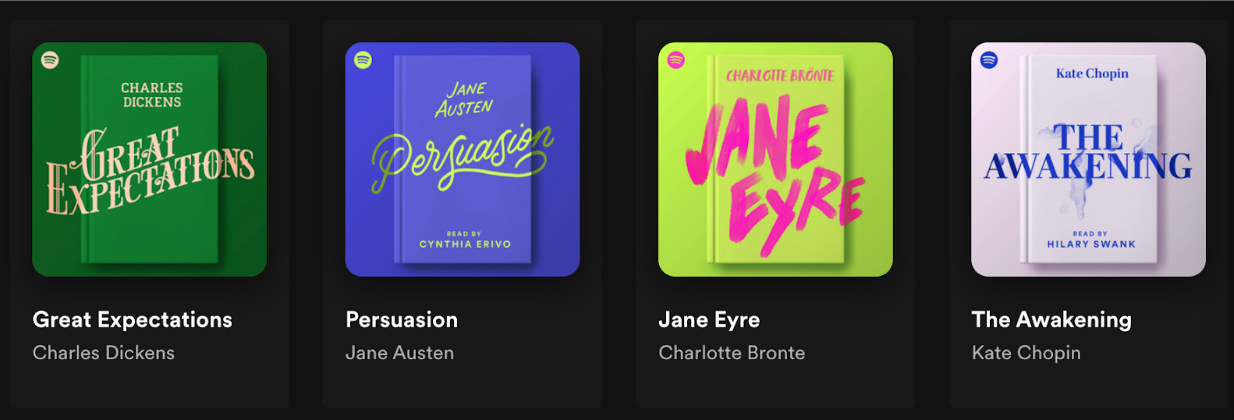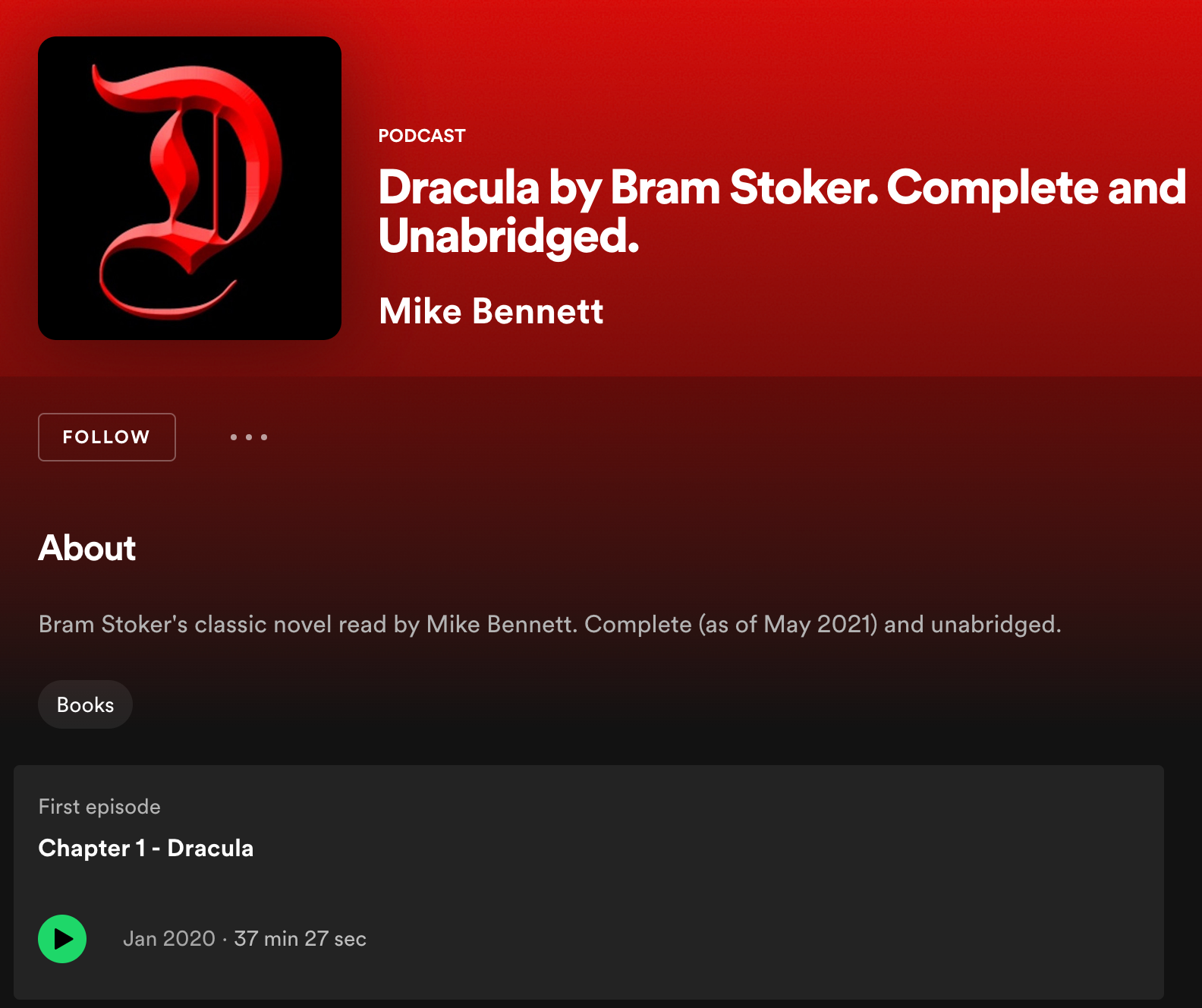Using Audiobooks
By Sophie H., a Writing Coach
As an English major, I read a lot of classic books for class, and I’ve always been committed solely to tangible, paper books. In short, I used to be an audiobook hater, and I didn’t understand why some people preferred to read books in that format. It seemed like that violated some reading code to me and my library card. Yet, once I got to college and the old books started to stack up on my desk and my eyes became fatigued from skimming the pages, I needed to try something new.
My breaking point came when I had to read Persuasion, Jane Eyre, Wuthering Heights, Great Expectations, The Mill on the Floss, and Tess of the D’urbervilles all for one class. I realized I had trouble staying focused not only because of the 19th century language of the books, but also because I just had so much to read.
This is a pattern I’ve noticed in my time at UNC: when I am busy, when I have to read more than one book at a time, and when the text is written in archaic language, I struggle to stay on top of things. With this struggle, I’ve found one strategy that helps me: listening to audiobooks (much to the dismay of my former self).
I put away my haughty reading perspective, started searching the internet for recordings of the books for my classes, and found so many! This is because many classic books are in the public domain, making them copyright-free and able to be reproduced in different forms by different people and companies.
What I Tried
Using this knowledge, I first came across a website called Book Audio Online which contained a vast amount of titles for free. Even though there were so many books on this website, it was difficult for me to use because the books were not divided into chapters, and if I left the website it would not save my place in my book. Although these are very minor issues in the face of having access to some many books, I kept searching in the hopes I would find an easier-to-use platform.
I moved to searching YouTube for books. Like Book Audio Online, it was overwhelming at first because of all of the options. I found that some recordings were incomprehensible because of their low sound quality and/or the voice of the reader, and some books were incomplete with only a few chapters; however, these audiobooks saved me many hours of eye-pain, especially because I could use YouTube’s settings to speed up the recording. Moreover, because I have a free YouTube account, my place in the recordings was always saved when I clicked off of the website or app.
I was not fully satisfied with the YouTube audiobooks, though, because they would sometimes be interrupted by ads and because I had to keep the YouTube app up and running on my phone while I listened on the go. This consistently made my phone die quickly and made it so I couldn’t use any other applications. As a result, I knew YouTube was going to be a great resource, but I still wanted to find another, perhaps easier-to-use, option. That’s when I started searching for books on Spotify.
What I Learned
I quickly found a multitude of classic books in the Podcasts section of Spotify, with the majority of the books divided into single podcast episodes for each chapter. This made it easy to keep my place in the book, and as a free Spotify member, all of my history was saved. Some of the recordings were really well-done too, with one version of Dracula having multiple voices, sound effects, and eerie music to start off each chapter. On Spotify, I could also speed up the recording if I wanted to – like the feature on YouTube – which made me get through some books faster than if I was physically reading them.
From this experience, I found Spotify’s recordings to be most wide-ranging and easy to operate, compared to the other platforms I had looked at. To hear the recordings without ads, I did have to subscribe and make an account, but there are discounts for college students that make the membership half-price, which I think is worth it.
How I Use Audiobooks
After trying different audiobook platforms and deciding that Spotify was my favorite, I found that I used audiobooks whenever I could to get ahead on reading. I did have to pay for a subscription, but Spotify has a great deal for students where it only costs $5 a month, as opposed to $10: all I had to do was send them a picture of my OneCard.
Spending that money cost less overall than buying physical books for class. I was able to listen to The Mill on the Floss when I walked to and from class, follow the plot of Wuthering Heights when I was making dinner, and turn on Great Expectations when I got ready for bed and started falling asleep. I didn’t have time to read hard copies, and I found that interweaving my reading (listening) into my everyday tasks was the best way to manage my time and get my readings done.
But, this is not to say it is a perfect system. Though using audiobooks has been helpful, I do find myself having to rewind and go back every once in a while because my mind will wander, someone will start talking to me, or I’ll get distracted by surroundings. Sometimes, I even fall asleep when listening to audiobooks, and I’ve found that I remember less of the books’ content when I listen to the book rather than read it on paper. Rather than knowing specific plot points, I instead have more broad understandings of the books. Yet, to me, having a general understanding was better than not reading at all.
Overall Reflections
When I read for class, I don’t normally take notes, so listening to audiobooks did not really impact me in this area. So, even though I prefer to read physical books, this strategy has helped me contribute to class discussions and know the background of books for research for course papers. If I hadn’t listened to the audiobooks, I would’ve felt like I was floundering and unprepared for class and assignments. Audiobooks are not the perfect solution for a busy life that requires a lot of reading, but they are extremely helpful when I have a full schedule and other things to do.
In essence, switching to using audiobooks for some of my classes has been beneficial because I have been able to finish more course readings in a timely manner and complete other tasks at the same time. By exploring different resources and finding my appreciation for Spotify’s audiobooks, I have been more on-top of my class readings in my busy times than I would’ve been without them.
This is not a catch-all for class though, and I did comprehend less information, which makes tests and things of that nature harder. Yet, by being able to listen to books at home, on campus, in the car, and wherever else I am, I am more generally prepared for class because I usually didn’t have the time to read my physical books at all. I am glad to have all of these resources available when I’m both on-the-go and when I’m at home to ultimately help me succeed in my coursework at UNC.




